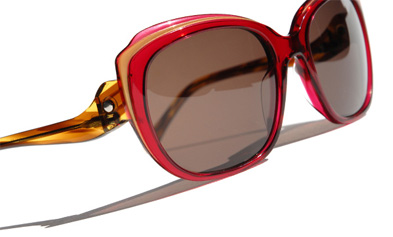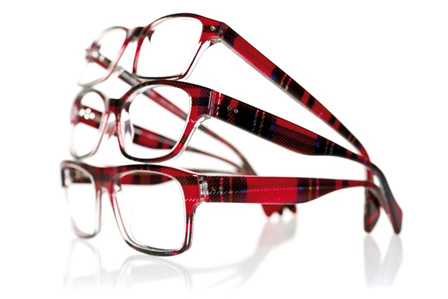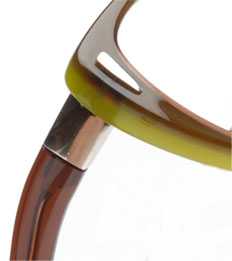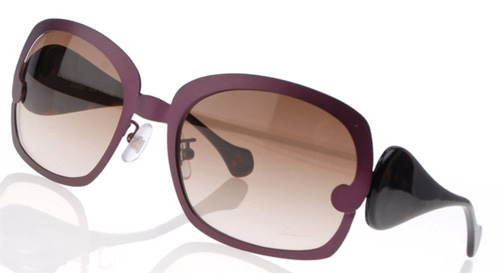Face à Face
 Face à Face eyewear is designed by French architect Alyson Magee and handmade by the finest craftsmen - in France for the optical frames, and in Italy for the sunglasses - who combine artistic skills with mastery of technological innovations. Like an architect Face à Face works with volumes, shapes, materials, colours and textures to give its glasses the power to express the personality of their wearer. Each collection is preceded by a research and a design stage, resulting in new styles enhanced by innovative concepts incorporating new sensibilities. The product expresses contemporary design, individuality, its capacity of being a vector of personal expression and of personal luxury. The quality and creativity of the collections have been rewarded several times. Face à Face optical frames and sunglasses can be seen in many TV shows and are worn by many famous people in movies as well as in real life.
Face à Face eyewear is designed by French architect Alyson Magee and handmade by the finest craftsmen - in France for the optical frames, and in Italy for the sunglasses - who combine artistic skills with mastery of technological innovations. Like an architect Face à Face works with volumes, shapes, materials, colours and textures to give its glasses the power to express the personality of their wearer. Each collection is preceded by a research and a design stage, resulting in new styles enhanced by innovative concepts incorporating new sensibilities. The product expresses contemporary design, individuality, its capacity of being a vector of personal expression and of personal luxury. The quality and creativity of the collections have been rewarded several times. Face à Face optical frames and sunglasses can be seen in many TV shows and are worn by many famous people in movies as well as in real life.
HISTORY
First created in 1995, Face à Face glasses grew out of a passion for architecture shared by a small group of eyewear enthusiasts. One of them, Pascal Jaulent, the creator of the original concept behind the collection, dreamt of giving eyewear the power to reflect the character of the person wearing it. ""Face à Face was designed to reveal the sense of the modern that's in all of us." Nadine Roth, his partner, felt that nothing could reflect the look that makes each of us what we are, better than our own eyes.
""Face à Face was designed to reveal the sense of the modern that's in all of us." Nadine Roth, his partner, felt that nothing could reflect the look that makes each of us what we are, better than our own eyes.
Like an architect, Face à Face works with volumes, shapes, materials, colours and textures to give its glasses the power to express the personality of their wearer, whether that's bold, carefree, energetic, independent or even seductive. Each collection is preceded by a research and design stage, resulting in new styles enhanced by innovative concepts incorporating new sensibilities. In ten years, with a collection renowned for its creativity and its "Made in France" quality, the company has gained a strong foothold in the world market for designer glasses (80% of its turnover comes from exports), opened a subsidiary in the United States, set up a production and finishing centre in the French Jura region and established a firm presence with its own shop dedicated exclusively to the brand, at 346 rue Saint Honore in the heart of Paris.
Our frames are manufactured in the Jura, France by the finest local craftsmen, who combine artistic skills with mastery of technological innovations.
There are many different steps between initial drawings, model prototypes and the first run of the final production. These can involve 2 to 10 different subcontractors depending on what material is used, and can take 6 to 24 months.
We hope that the steps listed below will give you a better understanding of how complex the manufacturing process of our frames is.
DESIGN
Our company's main office and the Face à Face design studio are located only a few steps from the Champs Elysees. It is here that for 3 years Pascal Jaulent, the original creator of the brand's concept, has been managing a team of talented designers that includes 3 Product Designers, one Graphic Designer, and one Model Maker. Together, they innovate in the functional solutions and construction of frames and create some of tomorrow's most beautiful eyewear.
 Since glasses are part of a person's look, they can convey as much about the wearer's character and feelings as the eyes themselves do. Like an architect, Face à Face works with volumes, shapes, materials and colours so the frame reveals personal expression.
Since glasses are part of a person's look, they can convey as much about the wearer's character and feelings as the eyes themselves do. Like an architect, Face à Face works with volumes, shapes, materials and colours so the frame reveals personal expression.
In order to bring unique and distinctive style to this concept, Face à Face bases its design process on many different artistic themes, including:
- Architecture and architectural design as a source of interactions between colours, light, materials, appearances, contrasts, volumes and plans.
- Functional research, because design, by its nature, requires an understanding of the functionalities and uses of the product.
- Graphic influences: linear, calligraphic, structural and print effects.
- The duality of Face à Face elements: two colours, two materials, double effects.
- The world of beauty and make-up, to enhance the wearer's look in the same way that fine cosmetics do.
- Colours, because colour is life.
PRODUCT DEVELOPMENT
Every project starts with an exchange of ideas that are quickly transformed into outlines, sketches, and then into a series of computer-generated drawings. Our model maker uses these initial drawing to produce a metal or acetate prototype. The projects are then forwarded to out technical Director (based in Jura). He and his team work with the research development departments of our manufacturers to determine whether the project is feasible.
Once the product design has been finalized and the final technical drawings digitized, the technical phase of the manufacturer process can start: manufacturing of the cutting and stamping tools necessary to make our exclusive metal components; programming the CNC (computerized numerical controls) machines, to machine the fronts and temples of our acetate frames.
This phase can take 2 to 6 months for acetate frames, and 6 to 18 months for metal frames, depending on how complex the project is.
THE PRODUCTION MANAGEMENT CENTER
In early 2002, Face à Face made the strategic decision to integrate production, and establish a production management structure as well as a workshop for the finishing of metal frames. There were several goals behind this decision:
- To follow and control the development of new collections
- To manage the manufacturing flow among the various subcontractors
- To ensure quality control of the parts between each stage of manufacturing (polishing, sanding, colour treatment)
- To carry out the finishing of the entire metal and titanium collection, which means: assembling the components, mounting the lenses, marking the frames and lenses, attaching the nose pads, assembling the acetate temple tips and final adjusting of the frames.
Mastering these stages helps to reduce delivery time and to improve the quality of the products.The size of the collection, its exceptional range of colours and its variety of assembly, together with the many new models introduced every season represent a constant challenge for the management of productions.
AND THE FACE À FACE FINISHING WORKSHOP
The facility is located in Montmorot (Jura), a small town close to Lons Le Saunier. It has been in full operation since January 2004, encompasses 300 m2 of the floor space and employs a dozen people.
The workshop finishes 6,000 to 7,000 metal and titanium frames a month, and the production management centre ensures that each of the 9,000 to 10,000 acetate frames go through the workshop each month meeting very high quality standards.
Tens of thousands of titanium and metal components pass through the centre each year, maintaining a permanent stock of no less than 5 tons of acetate, for an annual consumption of over 10 tons of material.
ACETATE FRAMES - THE MATERIAL
 The range of colours, and acetate laminations, the matt and shiny finishes, transparency, details and volumes express some of Face à Face's strongest design themes. Moreover, they determine to the wearer the very high quality of the frames.
The range of colours, and acetate laminations, the matt and shiny finishes, transparency, details and volumes express some of Face à Face's strongest design themes. Moreover, they determine to the wearer the very high quality of the frames.
Face à Face cuts its frames from the very beautiful acetates produced by Mazzuchelli, an Italian company, the world leader in acetate production. Acetate is a natural material (it is derivative of cotton) and is therefore highly non-allergenic. Single colour sheets are harmonized and cut entirely by hand, producing an unmatched wealth of colours and structures. Many types of acetates in the collection are exclusive to Face à Face (red cables, cables, safari, tatami, fibers, etc.) They are developed by our design studio in cooperation with Mazzuchelli. the Face à Face design spirit is therefore fully expressed in the structure of the acetates.
It can require over 12 months to design and exclusive material, and a further 4 months to deliver the finished acetate.
ACETATE FRAMES - MANUFACTURING
 Manufacturing an acetate frame requires more than 20 different operations, most of which are done by hand.
Manufacturing an acetate frame requires more than 20 different operations, most of which are done by hand.
After the production development phase, which last 2 to 6 months, the true production cycle starts: preparation of the materials in the workshop, delivery to the factory where series of highly technical manufacturing processes occur (i.e. cutting the fronts using digitally controlled machines). The entire handcrafted stages, such as corrugation (shaping the bridge by hand) and final felt polishing, are also performed entirely by hand.
From start to finish, each individual item requires 40 minutes of handcrafting. And under the best conditions production takes 6 to 8 weeks, not including the time needed for supplying the material.
TIMETABLE FOR ACETATE FRAME
PRODUCTION DEVELOPMENT: 2 TO 6 MONTHS
- Design/Drawing
- Models
- Validation
- Technical Analysis
- Finalizing Plan
- Prototype Production
- Tooling
PRODUCTION: 6 TO 8 WEEKS (MATERIAL SUPPLY NOT INCLUDED)
- Cutting out acetate sheets into strips
- Acetate strips are planed to the correct thickness and cut into blocks
- Small pieces of acetate are glued where the bridge and the side pieces will be, to increase thickness at these spots
- Machining of fronts using a CNC machine (8 to 15 fronts per hour)
- Hinges are inserted into the frames
- Manufacturing of the temples
- Corrugation: working the bridge by hand
- The end pieces are radiused
- Tumbler polishing: fronts and temples polished separately 3 phase - duration: one week
- Sanding
- Semi-soft sanding
- Shining
- Bending - working the front
- The bridge is then shaped out and finished by hand
- Assembling the temples
- Hand polished: 3 to 6 different operations
- Ultrasonic degreasing
- Cutting and mounting of demo lenses
- Marking of temples and lenses
- Final adjusting
- Forwarding to Face à Face logistics center
MANUFACTURING OF METAL FRAMES
All the components (side pieces, bridges, temples) of our metal and titanium frames are exclusive to Face à Face. They are developed by our team of designers and our technical director. Before they can be produced, special tools have to be made.
 Depending on the material and the degree of innovation of the model, it takes 6 to 18 months to develop and begin manufacturing a new product. The production cycles for the components (fronts, bridges, side pieces, temples, arcades) take an average of 4 months and can involve as many as 80 different steps. Once completed, these components are assembled and welded to become "semi-finished" products.
Depending on the material and the degree of innovation of the model, it takes 6 to 18 months to develop and begin manufacturing a new product. The production cycles for the components (fronts, bridges, side pieces, temples, arcades) take an average of 4 months and can involve as many as 80 different steps. Once completed, these components are assembled and welded to become "semi-finished" products.
Manufacturing titanium frames involves the greatest challenges, due to the extreme hardness of the material. It requires many specialized tools for each manufacturing stage.
The Face à Face titanium collection was the first to exploit the lightness of this material to produce fashionable thick and large frames, rather than obtaining the lightest frame possible. This could not be done with standard Monel metal because it is too heavy.
The metal and titanium frames are coloured with varnishes for non-metallic colours or plated with palladium, ruthenium, gold or galvani finishes. All our colour treatments are hypoallergenic. All Face à Face colours are specifically developed and produced for us by subcontracted colour technicians.
Pascal Jaulent, who manages the design teams, is a member of the "Comite Francais de la Couleur" (the French Committee for Colours). They represent a group of specialists from various fields who study the fashion, practical and symbolic aspects of colours as well as new trends.
TIMETABLE FOR METAL FRAMES
METAL FRAMES - COPPER NICKEL ZINC ALLOY - TITANIUM PRODUCTION DEVELOPMENT: 6 TO 8 MONTHS
- Design/Drawing
- Models
- Validation
- Technical Analysis
- Finalizing Plan
- Prototype Production
- Technical Validation
- Tooling
PRODUCTION OF SEMI FINISHED: 4 MONTHS
Manufacturing of the fronts, bridges, side pieces, temples:
Depending on the material and purpose of the part: up to 80 different operations for a single frame
- Swaging: reducing the section of a metal wire by pulling and tapping at the same time
- Cutting out metal plates
- Stamping
- Dieing
- Milling
TREATMENTS: 1 MONTH
- Polishing followed by quality inspection
- Sanding followed by quality inspection
- Color treatment followed by quality inspection
- Assembly of the rough product - welding
IN-HOUSE FINISHING: 1 WEEK
- Assembling of treated components
- Screwing the nose pads
- Marking the temples and temple tips
- Bending and assembling the temple tips
- Cutting and mounting of demo lenses
- Final adjusting of finished frame
- Forwarding to Face à Face logistics center
In order for Face à Face to be in the position to always present exceptional products, we have made the daring decision to invest several hundreds of euros in our production facility in Jura and to continue manufacturing our frames in France, at a time when most eyewear manufacturers are relocating their production to foreign countries.
These decisions were obvious to us for the following reasons:
- To be true to our spirit of designers, we want to constantly increase our knowledge of functional necessities and to push the technical limits as far as possible. Therefore it is crucial to be as close as possible to the factories, their manufacturing processes and industrial innovations.
- In order to maintain the highest production standards, we have to be close to our sub-contractors. Located near Lons Le Saunier, our factory is in the heart of the French optical manufacturing region, and its network of the best sub-contractors.
- To reach the the level of flexibility that allows us to meet our clients' requirements, we had no other option than building our own industrial organization.
- To maintain a legitimate level of innovation and manufacturing for the Face à Face clients, we had to implement the means to give our customer the design and quality satisfaction they have come to expect.
- The "Made in France" label printed proudly on every frame is widely acknowledged, alongside our innovative designs and our recognizable style, in contributing to Face à Face's success in exporting almost 80% of its frames to more than 50 countries around the world.
Thank you for your support over the past ten years. We look forward to continue bringing beauty and innovations to your clientele.
~ Face à Face







































